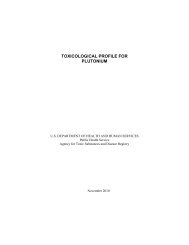BMC Evolutionary Biology
BMC Evolutionary Biology
BMC Evolutionary Biology
Create successful ePaper yourself
Turn your PDF publications into a flip-book with our unique Google optimized e-Paper software.
pleurodonts [17,135] in previous studies. Within Iguania (Figure 1), we find strong support<br />
(SHL = 100) for a sister-group relationship between Chamaeleonidae and Agamidae<br />
(Acrodonta), and for a clade of mostly New World families (Pleurodonta; SHL = 100).<br />
We find strong support for the monophyly of Chamaeleonidae and the subfamily<br />
Chamaeleoninae, and weak support for the paraphyly of Brookesiinae (Figures 1, 15). The<br />
sampled species of the Brookesia nasus group appear as the sister group to all other<br />
chamaeleonids (the latter clade weakly supported) as found by some previous authors [136],<br />
though other studies have recovered a monophyletic Brookesia [137,138]. Within<br />
Chamaeleoninae (Figure 15), we find strong support for the monophyly of most genera and<br />
species-level relationships. However, we find strong support for the non-monophyly of<br />
Calumma, with some species strongly placed with Chamaeleo, others strongly placed with<br />
Rieppeleon, and a third set weakly placed with Nadzikambia + Rhampoleon. While nonmonophly<br />
of Calumma has also been found in previous studies [138], a recent study strongly<br />
supports monophyly of Brookesia and weakly supports monophyly of Calumma [139].<br />
Monophyly of Agamidae is strongly supported (Figure 16; SHL = 100), contrary to some<br />
previous estimates [15,31]. Most relationships among agamid subfamilies and genera are<br />
strongly supported (Figure 16), and largely congruent with earlier studies [17,29,34,140].<br />
There are some differences with earlier studies. For example, previous studies based on 29–<br />
44 loci [20,29,34] placed Hydrosaurinae as sister to Amphibolurinae + (Agaminae +<br />
Draconinae) with strong support, whereas we place Hydrosaurinae as the sister-group to<br />
Amphibolurinae with weak support. Other authors [140] placed Leiolepiedinae with<br />
Uromastycinae, but we (and most other studies) place Uromastycinae as the sister group to all<br />
other agamids.<br />
Our phylogeny indicates several taxonomic problems within amphibolurine agamids (Figure<br />
16). The genera Moloch and Chelosania render Hypsilurus paraphyletic, although the support<br />
for the relevant clades is weak. The species Lophognathus gilberti is placed in a strongly<br />
supported clade with Chlamydosaurus and some Amphibolurus (including the type species,<br />
A. muricatus), a clade that is not closely related to the other Lophognathus. Many of these<br />
taxonomic problems were also noted by previous authors [141].<br />
Within agamine agamids (Figure 16), most relationships are well supported and monophyly<br />
of all sampled genera is strongly supported. In contrast, within draconine agamids (Figure<br />
16), many intergeneric relationships are weakly supported, and some genera are nonmonophyletic<br />
(Figure 16; see also [142]), including Gonocephalus (G. robinsonii is only<br />
distantly related to other Gonocephalus) and Japalura (with species distributed among three<br />
distantly related clades, including one allied with Ptyctolaemus, another with G. robinsonii,<br />
and a third with Pseudocalotes).<br />
Recent authors suggested dividing Laudakia into three genera (Stellagama, Paralaudakia,<br />
and Laudakia) based on a non-phylogenetic analysis of morphology [143]. Here, Laudakia<br />
(as previously defined) is strongly supported as monophyletic (Figure 16), and this change is<br />
not necessitated by the phylogeny. Similarly, based on genetic and morphological data, recent<br />
authors [144] suggested resurrecting the genus Saara for the basal clade of Uromastyx (U.<br />
asmussi, U. hardwickii, and U. loricata). However, Uromastyx (as previously defined) is<br />
strongly supported as monophyletic in our results (Figure 16) and in those of the recent<br />
revision [144], and this change is not needed. We therefore retain Laudakia and Uromastyx as<br />
previously defined, to preserve taxonomic stability in these groups [113]. We note that recent



